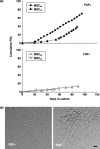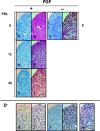Possibility of selection of chondrogenic progenitor cells by telomere length in FGF-2-expanded mesenchymal stromal cells
- PMID: 17109640
- PMCID: PMC6496787
- DOI: 10.1111/j.1365-2184.2006.00397.x
Possibility of selection of chondrogenic progenitor cells by telomere length in FGF-2-expanded mesenchymal stromal cells
Abstract
Telomere length plays an important role in regulating the proliferative capacity of cells, and serves as a marker for cell cycle history and also for their remaining replicative potential. Mesenchymal stromal cells (MSC) are known to be a significant cell source for therapeutic intervention and tissue engineering. To investigate any possible limitations in the replicative potential and chondrogenic differentiation potential of fibroblast growth factor-2-expanded MSCs (FGF(+)MSC), these cells were differentiated at various population doublings (PDs), and telomere length and telomerase activity were measured before and after differentiation. FGF(+)MSC cultured at a relatively low density maintained proliferation capability past more than 80 PD and maintained chondrogenic differentiation potential up to at least 46 PD and long telomeres up to 105 PD, despite expressing low levels of telomerase activity. Interestingly, upon chondrogenic differentiation of these cells, telomeres showed a remarkable reduction in length. This shortening was more extensive when FGF(+)MSC of higher PD levels were differentiated. These findings suggest that telomere length may be a useful genetic marker for chondrogenic progenitor cells.
Figures



Similar articles
-
Telomere length and telomerase activity during expansion and differentiation of human mesenchymal stem cells and chondrocytes.J Mol Med (Berl). 2004 Jan;82(1):49-55. doi: 10.1007/s00109-003-0506-z. Epub 2003 Nov 28. J Mol Med (Berl). 2004. PMID: 14647922
-
Neoplastic transformation by TERT in FGF-2-expanded human mesenchymal stem cells.Int J Oncol. 2011 Jul;39(1):5-11. doi: 10.3892/ijo.2011.1029. Epub 2011 May 3. Int J Oncol. 2011. PMID: 21573488
-
FGF-2 addition during expansion of human bone marrow-derived stromal cells alters MSC surface marker distribution and chondrogenic differentiation potential.Cell Prolif. 2013 Aug;46(4):396-407. doi: 10.1111/cpr.12046. Cell Prolif. 2013. PMID: 23869761 Free PMC article.
-
Telomere stability and telomerase in mesenchymal stem cells.Biochimie. 2008 Jan;90(1):33-40. doi: 10.1016/j.biochi.2007.09.005. Epub 2007 Sep 25. Biochimie. 2008. PMID: 18029083 Review.
-
Influence of cellular microenvironment and paracrine signals on chondrogenic differentiation.Front Biosci. 2007 Sep 1;12:4946-56. doi: 10.2741/2440. Front Biosci. 2007. PMID: 17569622 Review.
Cited by
-
Telomeres and Telomerase in the Control of Stem Cells.Biomedicines. 2022 Sep 20;10(10):2335. doi: 10.3390/biomedicines10102335. Biomedicines. 2022. PMID: 36289597 Free PMC article. Review.
-
Telomere and telomerase in stem cells.Br J Cancer. 2007 Apr 10;96(7):1020-4. doi: 10.1038/sj.bjc.6603671. Epub 2007 Mar 13. Br J Cancer. 2007. PMID: 17353922 Free PMC article. Review.
-
Upregulation of Adipogenesis and Chondrogenesis in MSC Serum-Free Culture.Cell Med. 2011 Jun 1;2(1):27-41. doi: 10.3727/215517911X575984. eCollection 2011. Cell Med. 2011. PMID: 26998400 Free PMC article.
-
Environmental preconditioning rejuvenates adult stem cells' proliferation and chondrogenic potential.Biomaterials. 2017 Feb;117:10-23. doi: 10.1016/j.biomaterials.2016.11.049. Epub 2016 Nov 25. Biomaterials. 2017. PMID: 27923196 Free PMC article. Review.
-
Challenges in identifying the best source of stem cells for cardiac regeneration therapy.Stem Cell Res Ther. 2015 Mar 13;6(1):26. doi: 10.1186/s13287-015-0010-8. Stem Cell Res Ther. 2015. PMID: 25886612 Free PMC article. Review.
References
-
- Baxter MA, Wynn RF, Jowitt SN, Wraith JE, Fairbairn LJ, Bellantuono I (2004) Study of telomere length reveals rapid aging of human marrow stromal cells following in vitro expansion. Stem Cells 22, 675–682. - PubMed
-
- Bianchi G, Banfi A, Mastrogiacomo M, Notaro R, Luzzatto L, Cancedda R, Quarto R (2003) Ex vivo enrichment of mesenchymal cell progenitors by fibroblast growth factor 2. Exp. Cell Res. 287, 98–105. - PubMed
-
- Bryan TM, Reddel RR (1997) Telomere dynamics and telomerase activity in in vitro immortalised human cells. Eur. J. Cancer 33, 767–773. - PubMed
-
- Caplan AI, Bruder SP (2001) Mesenchymal stem cells: building blocks for molecular medicine in the 21st century. Trends Mol. Med. 7, 259–264. - PubMed
-
- Deans RJ, Moseley AB (2000) Mesenchymal stem cells: biology and potential clinical uses. Exp. Hematol. 28, 875–884. - PubMed
Publication types
MeSH terms
Substances
LinkOut - more resources
Full Text Sources
Other Literature Sources
Miscellaneous

